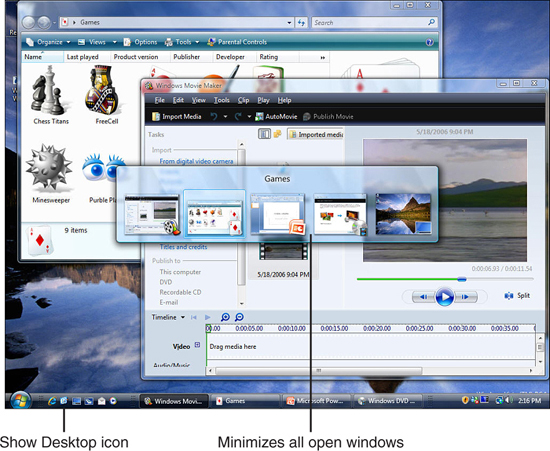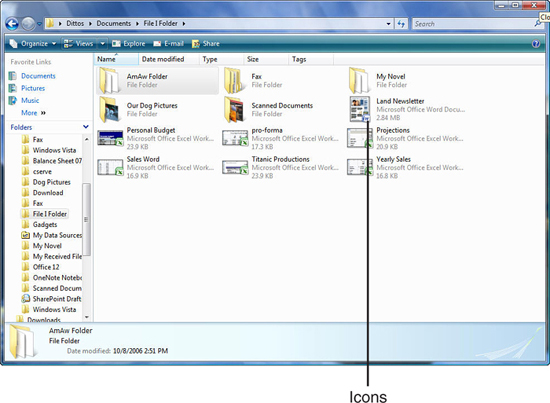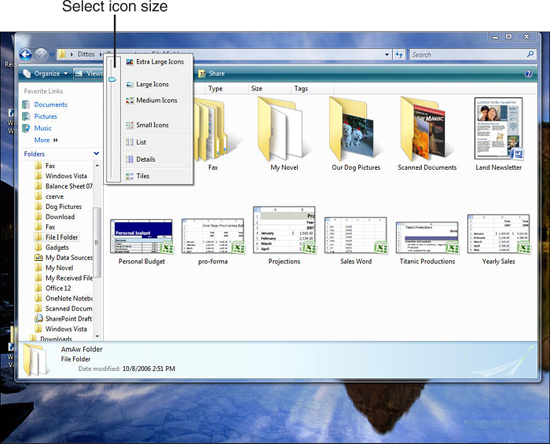Chapter 5. Managing Your Programs
In This Chapter:
- Master program and window control
- Utilize see-through window borders
- Switch between windows and programs
- Use icons to give you live previews in file lists
- Change icon sizes when needed
As you know, Windows Vista is an operating system. An operating system serves many purposes, but primarily, it exists so that your hardware can talk to your software. The operating system sets up a uniform data exchange so that your programs recognize all the different devices you’ve attached to your computer.
The operating system also serves as a conduit between you and your programs. With Vista you interact with your programs by entering information, triggering hardware device activity (such as printing), and adjusting programs and windows so that they behave the way you need them to behave.
Only after mastering Windows Vista’s interface and understanding its nuances will you be able to tackle multiple, open programs and windows effectively. In this chapter, you’ll learn how to arrange and switch between your windows in an efficient manner. Then you’ll leverage this chapter’s tools in the next chapter as you learn ways that the Taskbar and help speed up what you want to do. Vista enables you to have full control over your windows and taskbar, modifying the way they all work to suit your preferences.
Manage Multiple Programs and Windows
Unless you’re brand new to computers, you know by now that an operating system such as Windows enables you to run several programs at the same time. In your word processor, you could begin to print a long document, then you can start your email program and retrieve your Inbox messages, and while those messages are loading, you can fire up Media Player and listen to some music. Your computer multitasks all these operations in separate windows. Even if you see only one of the open windows, the activities you began in the other windows keeps moving.
Being an efficient and effective computer user means that you have the ability to manage all your open windows. Knowing how to arrange the windows and how to manipulate them enhances your ability to use your PC.
Even if you’re a computer pro, you’ll be thankful for Vista because it improves on the old XP-style ways of managing your open programs and windows. As with much of Vista, you’ll still do much of your window management using the old, familiar ways but Vista usually has a new trick in store.
Working with the See-Through Windows
If your computer supports the Aero Glass feature, just a quick glance at your desktop reveals little ways that Vista improves on past Windows versions. The goal of Vista is to give you tools to help you do your job more quickly, easily, and effectively. One way that Windows Vista does this is by offering you somewhat transparent window borders called translucent windows. Some windows display more transparency than others do; the border is always translucent and often more parts of the windows are.
As Figure 5.1 shows, the border of the smaller window allows some of what lies underneath to show. (Note that a window’s title bar might not always display a title.) With previous versions of Windows, when one program window covered another, you had no way to know what was under the top window without dragging it to the left or right to see what was underneath.
Figure 5.1. In addition to the transparency feature that Aero Glass provides, you can move and resize Vista windows exactly the way you’re used to if you’ve used previous versions of Windows.

By the Way
Sure, you can’t typically read clearly what’s under a window’s border because the border is only semi-transparent. Generally, however, you’re somewhat familiar with the programs you run on a regular basis. The semi-transparent effect is often enough to let you know what’s beneath a window when you have multiple windows open at the same time. In addition, Windows sometimes pops up a window with a warning or error message and those pop-up windows are often transparent to some extent so as not to cover up more than necessary.
If you don’t have hardware that supports Aero Glass, you don’t have the transparent border effect. However, because routing tasks such as moving and resizing windows still works in the usual way, much of this chapter applies to you, whether or not you get to see Vista’s transparency effects in action.
Did you Know?
If you want to turn off the Aero Glass effect and return to a Windows XP interface style, right-click over your computer’s desktop background and select Personalize. Click to open the Theme group and change the current theme to Windows Classic. Your translucent window borders will go away, and the Aero Glass effect will change back to more of the icon-like views that Windows XP offered. You can switch back to Aero Glass by selecting the Windows Vista theme once again.
When you maximize a window, its borders are not translucent. A maximized window displays its border in a solid color hue (often black), but the exact color depends on the Windows settings you’ve set. When you restore the window back to a smaller-than-maximized state (but not minimized), the window’s borders and sometimes part of the window’s background again turns translucent.
You’ll notice from Figure 5.1 that the control buttons are the same for Vista as for other versions of Windows (although the Maximize button has a slightly different look). To move a window, just click and hold anywhere within its title bar and drag the window elsewhere. If you use multiple monitors, you should be able to drag a window from one monitor to another without any problem.
To resize a window, point to an edge or corner of the window. When you do, your mouse pointer changes to a double-pointing arrow and you can drag the edge of the window to change its size.
Watch Out!
You won’t be able to resize all windows. Windows such as dialog boxes and other windows designed by programmers to be a fixed size won’t allow you to resize their borders.
Always remember that you can resize most File, Open dialog boxes such as the one in Figure 5.2. When your disk drive contains lots of files, being able to expand the Open dialog box is useful for quickly traversing a long list of files to locate a particular file.
Figure 5.2. Being able to resize Open dialog boxes allows you to locate files more easily when you have a large disk and folders with lots of files.

Make sure that you know the difference between a closed window and a minimized window. If you start a program such as the Calculator and click the Calculator’s Close button, Vista shuts down the Calculator program and you can no longer use it (without restarting the program again).
If, instead of the Close button, you click the Minimize button on the Calculator program’s window, Vista removes the program from your screen but keeps the program active and in memory. The taskbar will still show a button for the Calculator program and you can return to the Calculator without reopening it by clicking its taskbar button or by pressing Alt+Tab or Windows+Tab until the Calculator appears again.
Switching Between Windows
If you don’t close a program or open folder window, you can still open another. Keeping more than one window open at a time is how you multitask computer programs. You can start your Calculator program, and then start your word processing program without closing and without minimizing the Calculator program first.
After you open several programs, you have to switch between the programs. One way is to click the taskbar button that corresponds to the program to which you want to switch. To help you determine which open program or folder window you want to switch to, Vista’s Aero Glass feature displays a thumbnail image of the window as you move your mouse over each open program window button on your taskbar (see Figure 5.3).
Figure 5.3. Point to any taskbar button to see a thumbnail image of that program currently running on your computer.

Thumbnails like the one shown here are live, so if you have a video program playing, for example, the taskbar button’s thumbnail image shows a live feed of that video. This is especially helpful if you have multiple windows of the same program open at the same time because the thumbnail image helps you quickly locate the specific window you want to work with next.
If your graphics hardware doesn’t support Aero Glass, the name of the program or folder appears as you move your mouse pointer over the taskbar buttons.
By the Way
Although you can have multiple programs and windows open, you can work in only one at a time. The window that is currently in view, with its title bar showing, is the foreground window, and all other windows are background windows. No other program’s window covers your foreground window. As you switch to a program, Vista brings the program window to the top of the stack of windows on your desktop. If the window was minimized on your taskbar before you switched to it, the window will now be visible.
Instead of clicking the taskbar buttons to switch between programs, you can press Alt+Tab. Doing so pops up the task switcher window shown in Figure 5.4. Each thumbnail image represents an open program window. As you keep pressing Tab while holding down the Alt key, the next thumbnail in the task switcher highlights. The thumbnail image you stop on is the one whose program will become active in the foreground.
Figure 5.4. Press Alt+Tab to switch between programs.

Vista always includes the Show Desktop thumbnail when you press Alt+Tab. The Show Desktop thumbnail allows you to quickly minimize—but not close—all open windows and display your desktop. Therefore, instead of stopping on a program or folder window, if you stop on the Show Desktop thumbnail image when pressing Alt+Tab, Vista minimizes all your open windows and takes you to your desktop. You can also click your taskbar’s Show Desktop icon to minimize all open windows.
Did you Know?
Anytime you want to clear your desktop of all open windows without closing all your windows, the Windows+D shortcut command is often quicker to use than clicking the Show Desktop Taskbar icon and quicker than clicking Alt+Tab until the Show Desktop thumbnail highlights. Press Windows+D again and your open windows reappear where you left them.
If you don’t have Aero Glass–compatible graphics hardware, Vista displays icons and descriptions instead of thumbnails as you Alt+Tab between your open windows.
Pressing Windows+Tab produces the Vista’s new Flip 3D effect that enables you to scroll through your program windows. Shown in Figure 5.5, as you press Windows+Tab, the open programs rotate through the scrolling list of screens. If you don’t have Aero Glass–compatible hardware, Windows+Tab switches among your taskbar buttons, highlighting each one as you press the keys. In addition to scroll through the windows using Windows+Tab you can also scroll your mouse’s wheel to scroll the Flip 3D windows. Left-clicking on any window in the Flip3D view activates that window.
Figure 5.5. Press Windows+Tab to switch between programs using Aero Glass’s Flip 3D rotational display.

Did you Know?
Vista supports numerous keyboard shortcuts such as Windows+Tab and Alt+Tab. For a list of the most useful keyboard shortcuts, see Appendix A, “Common Vista Keyboard Shortcuts."
By the Way
Even if you have a graphics card that supports DirectX 9.0 or higher (the requirement to use Aero Glass), you still won’t see Aero Glass features if you’re using the Vista Starter or the Windows Vista Home Basic versions of Vista.
Visual Icons All Over
Windows Vista is more visual than any operating system before. You’ll notice signs of Vista’s graphics base just about everywhere you look.
For example, when viewing a list of files, such as you would do in Windows Explorer, Vista uses icons that actually represent the contents of each file in folders. These are called live icons because they represent the exact picture of the graphic file (which might be a video) they represent. For example, in Figure 5.6, the icon to the left of each graphic image is a tiny thumbnail of the actual picture. Instead of every JPEG image using the same standard icon (unless you don’t have the Aero Glass feature), your icons visually show you the contents of files. This holds true for many kinds of files. For example, a Word document’s icon is a thumbnail image of that document’s first page.
Figure 5.6. Small icons reflect the contents of your files.

By the Way
Although the default size of the icons is small, having them gives you one more shortcut when using Vista. Instead of opening a file to see its contents or clicking to change the view of the Explorer window, the icon itself gives you a clue as to the file’s contents.
For those times when the icons next to files in a list are too small, select from the pull-down View option, shown in Figure 5.7, to display larger icons for your files. Move the slider control up and down to resize the live icons so that you can see them comfortably.
Figure 5.7. Each window’s View option provides several icon sizes you can select to see your file contents better.

Chapter 8, “Mastering Vista’s Explorer Windows,” goes into more depth on the various Vista Explorer windows, menus, and options.
Chapter Wrap-Up
This chapter explored some of the ways you can use Vista’s functionality to get your work done faster and more effectively. Microsoft modified much in Vista to improve your computing experience. Sometimes only a minor tweak, such a showing you live icons of your documents and pictures in Windows Explorer, is a tiny change that can make you far more efficient as you use your computer.
Another vital Windows Vista element is your taskbar at the bottom of your screen. You’ve already noticed some of the taskbar’s advantages, such as displaying thumbnail images of the open programs and windows the taskbar buttons represent. Many more ways exist to utilize your taskbar effectively.
Many people use the taskbar only for switching between open programs and for seeing the current time, but the taskbar does far more than that. After you master the next chapter, you’ll be using the taskbar in ways you might not have known were possible. The taskbar can actually replace some of your Start menu’s functionality, making you more efficient at your computer.
